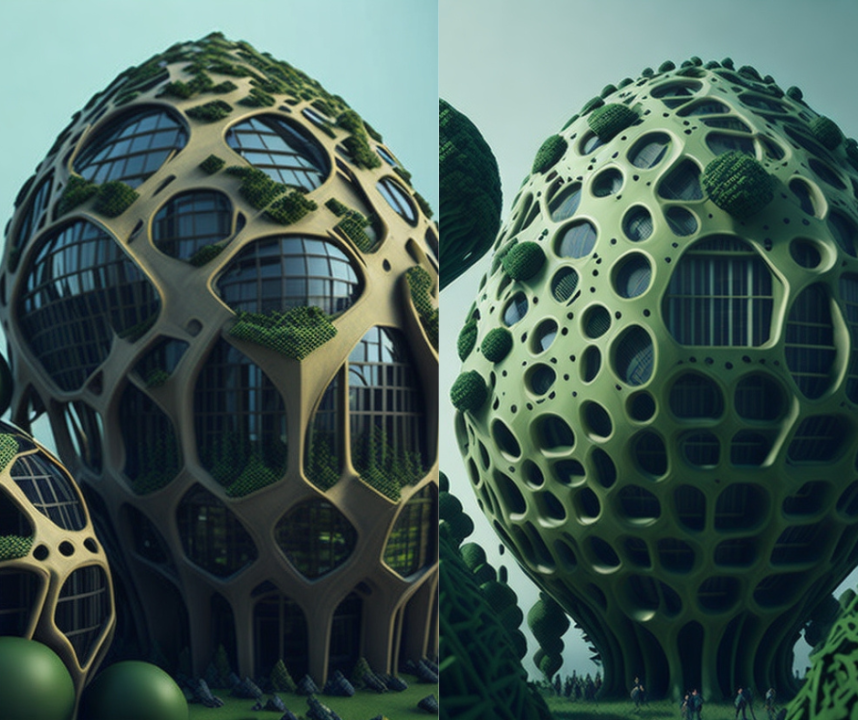
"Bacterial Builders: Cultivating a Sustainable and Living Architecture Revolution"

Imagine a world where buildings are not constructed, but grown by bacteria. Sounds like science fiction, right? Well, not anymore. Researchers have been exploring the potential of using bacteria to create sustainable and eco-friendly materials for architecture and design.
Bacteria are microscopic organisms that can perform various functions, such as breaking down organic matter, producing energy, and synthesizing compounds. Some bacteria can also produce minerals, such as calcium carbonate, that can bind together sand or soil particles to form solid structures. This process is called biomineralization, and it is the basis of how bacteria can grow buildings.
Biomineralization has many advantages over conventional construction methods. It is cheaper, faster, and more energy-efficient. It also reduces the environmental impact of building materials, as it does not require mining, transportation, or processing of raw materials. Moreover, it creates structures that are biodegradable, adaptable, and resilient to natural disasters.
One of the pioneers of bacterial architecture is Ginger Dosier, the founder and CEO of bioMASON, a company that uses bacteria to grow bricks from sand. Dosier was inspired by the way corals form their skeletons by depositing calcium carbonate around themselves. She wondered if she could mimic this process to create bricks without firing them in a kiln, which consumes a lot of energy and emits greenhouse gases.
Dosier developed a method that involves placing sand in molds and inoculating it with bacteria that produce calcium carbonate. The bacteria feed on a nutrient solution that is sprayed on the sand, and as they grow, they cement the sand particles together. After a few days, the bricks are ready to be used for building. Dosier claims that her bricks are stronger and more durable than conventional ones, and that they can be grown in any shape or size.
Another example of bacterial architecture is the Hy-Fi project by David Benjamin and his team at The Living, a design studio based in New York. The project was commissioned by MoMA PS1 for its Young Architects Program in 2014, and it consisted of a circular tower made of organic bricks grown from corn stalks and living root structures.
The bricks were grown in a lab by placing corn stalks in plastic molds and adding mycelium, which are the root-like structures of mushrooms. The mycelium acted as a natural glue that bonded the corn stalks together. After a few days, the bricks were removed from the molds and dried in an oven. The bricks were then stacked together to form the tower, which had a reflective coating on the inside to create a cool and luminous interior.
The Hy-Fi tower was designed to be a temporary and zero-waste installation, as the bricks could be composted after the exhibition. Benjamin and his team wanted to demonstrate how biological materials can offer new possibilities for architecture and design, as well as challenge the perception of what is natural and artificial.
Bacteria are not only capable of growing buildings, but also of repairing them. A team of researchers from Newcastle University and Northumbria University have developed a type of concrete that can heal itself by using bacteria. The concrete contains tiny capsules filled with bacteria and calcium lactate, which are embedded in the concrete mix. When cracks appear in the concrete, the capsules rupture and release the bacteria and calcium lactate into the crack. The bacteria then feed on the calcium lactate and produce limestone, which fills up the crack and restores the strength of the concrete.
The self-healing concrete could reduce the cost and environmental impact of maintaining concrete structures, as well as extend their lifespan and safety. The researchers estimate that their concrete could heal cracks up to 0.8 mm wide, which account for more than 90% of cracks in concrete structures.
These are just some examples of how bacteria can revolutionize the field of architecture and design. By harnessing the power of these tiny organisms, we can create buildings that are not only functional and beautiful, but also sustainable and alive.